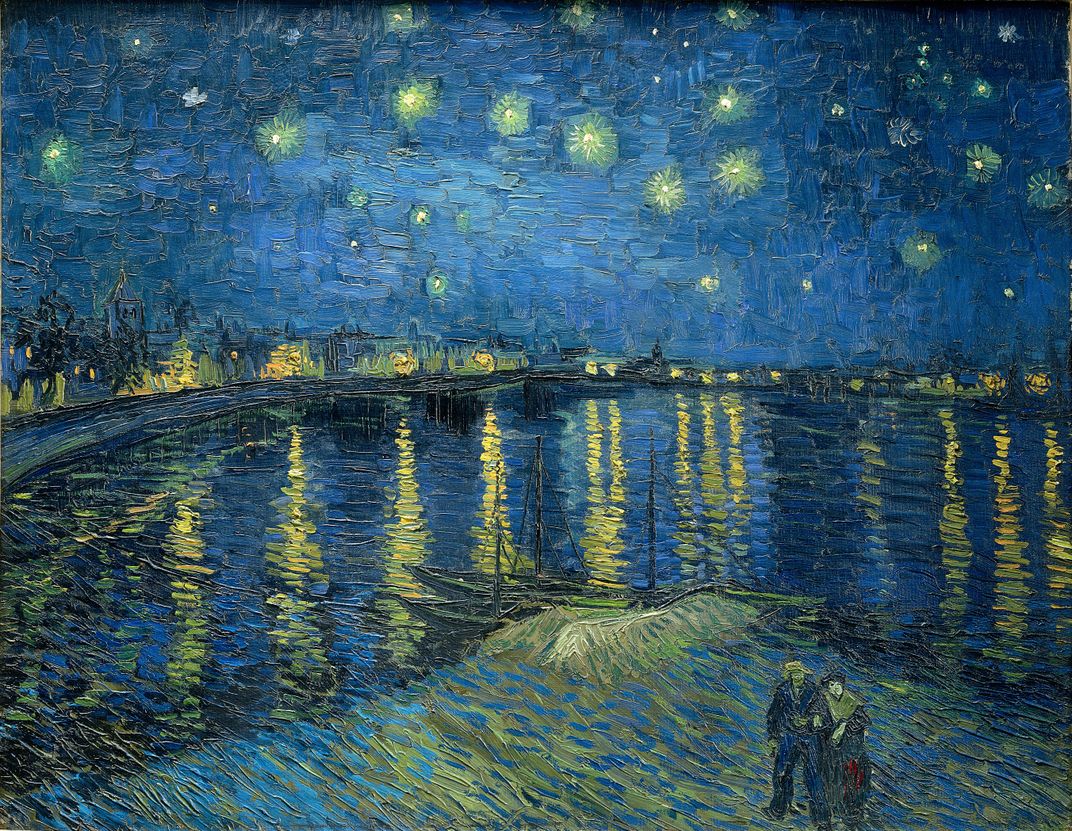Creating a Full Palette of Blues
How the discovery of a new metal helped to change painting forever
/https://tf-cmsv2-smithsonianmag-media.s3.amazonaws.com/filer/27/d2/27d2b6b5-1eef-499e-9dd6-153f6e38572d/van_gogh_-_starry_night_-_google_art_project.jpg)
Georg Brandt, born on this day in 1694, holds the distinction of being the first named person to isolate a new metal since ancient times. The Greeks and Romans knew about gold, silver, copper, iron, tin and lead, but in terms of metals, that was it. They didn’t know about cobalt, the metal that Brandt discovered and that helped change painting forever.
Brandt's discovery of cobalt wasn’t single-handedly responsible for everything that came after it, but it did help to catalyze a chain of discoveries and creative decisions that led to blue becoming a mainstream color in painting. That in turn produced some of the most iconic works of the nineteenth century–like Vincent Van Gogh’s Starry Night.
Early 1700s: Prussian Blue, the first synthetic pigment, discovered in Berlin
Prussian Blue was discovered by two German scientists–Johann Conrad Dippel, an alchemist, and Johan Jacob Diesbach, a pigment and dye maker. According to Alexander Kraft writing in the Bulletin for the History of Chemistry, the traditional story about its discovery is that the two were working on other projects in the laboratory and discovered the blue pigment by accident. Another man, Johann Leonard Frisch, got involved with selling the new color and may have improved on the method of producing it.
Letters from the period show that there was much scientific interest in the new color, which was being called “Berlin Blue” or “Prussian Blue” by 1709. But how it was made–by combining iron oxides in the correct proportions–remained undisclosed for about 20 years. There was a market for the blue, which was used in dyes and paints, and its discoverers wanted to profit from it.
“Demand for the new pigment was enormous, and it quickly gained widespread adoption in both oil painting and watercolors,” Philip McCouat writes in the journal Art in Society.
1733: Georg Brandt discovers and names cobalt in Stockholm
“As revolutionary as this new blue color proved to be, Prussian blue was a mere precursor to the explosion of available colors brought about by the Industrial Revolution,” writes the Norton Simon Museum.
Brandt’s discovery of cobalt blue was an important part of this next phase. The color had been used for centuries to give glass and pottery brilliant blue finishes, but there was a lot of uncertainty about where exactly the color came from. At the time, according to Jefferson Lab, it was commonly thought that the bismuth present with cobalt was what gave the ceramics their color. But Brandt thought differently.
Bismuth was one of what Brandt considered to be “semi-metals” according to The Journal of Chemical Education: substances “which [resemble] the metals in color, weight and form but which [are] not malleable.” Today those metals are referred to as metalloids, although what is defined this way has changed a bit. He named it cobalt after the German word for brownie or sprite, "kobold."
1802: Thénard builds on Brandt’s work to create cobalt blue pigment for painting in France
Baron L. J. Thénard discovered how to use cobalt, aluminum oxide and phosphoric acid to produce the cobalt blue pigment used by artists. Writing for the J. Paul Getty Trust's blog, John Griswold notes that Thénard was working in the post-Revolutionary French Republic, which was desperately seeking “to develop new products and revive the shattered economy.”
“A centerpiece of this effort was the nationally subsidized quest for new paint pigments inspired by the brilliant ceramic glazes seen on French royal porcelain, resulting in the discovery of cobalt blue and its variants,” he writes.
The same effort ultimately led to the creation of an affordable "true blue," writes Griswold: Called French ultramarine, this synthetic color was a combination of several less expensive minerals but had the color of ground lapis, which was the oldest and most expensive blue paint on the market.
“Painters at last had an affordable, fully balanced palette of cool and warm colors spanning the full spectrum,” writes the Norton Simon Museum. Painters innovated with this glut of new blues. Take Starry Night Over the Rhône, for example: Van Gogh used all three of the new colors—Prussian blue, cobalt and ultramarine—to capture the nighttime hues of the Rhône river, according to the Musée d’Orsay.
